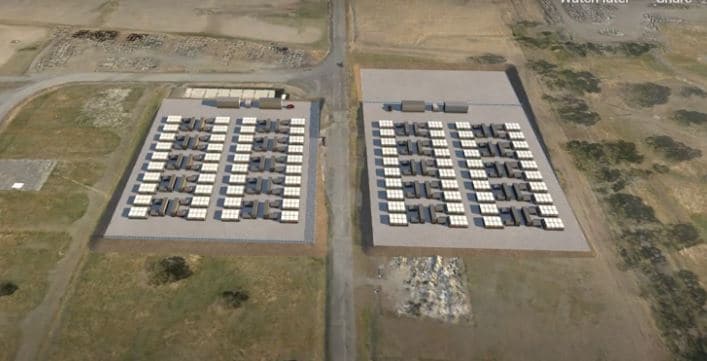In 2015, Sunwiz Managing Director Warwick Johnston warned large-scale solar developers that rooftop PV installations would end up eating their lunch.
“Now what I see is more nuanced and circular than that – renewables will eat itself,” he tells pv magazine Australia. “Transmission takes a long time to built … while you’re waiting for that transmission, there will be volatile and higher electricity prices. The natural response to that will be to install rooftop PV or install storage, potentially local storage, potentially local transmission-enhancing storage, all that sort of stuff.”
He said that batteries will be completed faster than transmission, leading to a decline in the economic justification for transmission. However, transmission projects will still be developed, which in turn will diminish the economic rationale for batteries.
While this business case conundrum most pointedly impacts big battery projects, which earn most of their revenue from spot markets, distributed energy resources like rooftop solar and network batteries will continue to utterly transform energy systems.
In April, Gabrielle Kuiper, a director of the Superpower Institute, noted the findings of ITP Renewables' modeling, which suggests that once Australia reaches its saturation point with distributed energy resources, rooftop solar combined with battery trading could potentially reduce the evening peak of the wholesale market by 67% to 92%.
The demand forecasts which have underpinned much of Australia’s transition modeling to date are increasingly being questioned, given the fact models – as Kuiper points out – have the shortfall of relying on a past which is likely completely different to the energy future.
Johnston describes the assumption that Australia should be building copious amounts of transmission as something that has remained, until vey recently, “unexamined.” A growing choir of industry insiders are questioning whether the current extent of planned transmission projects are in fact vital, but this is also a relatively recent shift.

To continue reading, please visit our pv magazine USA website.
This content is protected by copyright and may not be reused. If you want to cooperate with us and would like to reuse some of our content, please contact: editors@pv-magazine.com.




Great article!
Coming from WA, the notion that localised storage might be cheaper and more reliable than building “extension cords” makes perfect sense.
AEMO should plan for new interconnects but also include battery-equivalents and model these alongside using accelerated pricing and timing as batteries will be built much faster and cheaper than is currently modelled.
Finally it seems that an analyst has looked at trends in the population and industry rather than just laying current status and old fossil fuel projected issues with population and usage growth as a basis for their work. The only limiting factor is solar power panel limitations of under 30% efficiency that is unlikely to be solved in the next few decades (but obviously I could be wrong)
The sudden and huge uptake of electric cars, the advancements in battery technology and lowering of cost is changing our power usage landscape dramatically and these changes will continue to lessen our need for long distance transmission.
I can’t wait to walk in a city knowing that I’m no longer being poisoned at every breath.
With the decarbonisation of industry, transmission lines and baseload generation will be at a premium by 2040. Industry will require 5-10 times current generating capacity, and this will need to be transmitted across vast distances to meet the demand
I think retailers are very slow in supporting neighbourhood our community batteries. These would prime the revolution discussed here. The price point for standalone batteries and uncertainty over their performance as well as space and aesthetics are barriers these would reduce or eliminate, yet there are only a very few schemes and they are overpriced.
It appears likely thermal storage and EVs will drink enough of the milkshake that transmission and centralized battery storage will have a hard time. These two loads represent a massive amount of flexible load which will tend to compress the delta between low and high load hours. The traditional definition of low and high load hours is itself being challenged by new daily, weekly and seasonal patterns. I work with a former energy trader and we’ve discussed some of the weird pricing patterns in the Western US. By weird, I mean LLH pricing which is higher than HLH pricing.
It wasn’t so long ago, we traded electricity between Balancing Areas with phone calls and hand-written receipts – this was happening into the mid to late 1990s. Telecommunication advancements, Open Access rules and automation have pushed us into a world of 15-minute pre-scheduling slots and 5-minute balancing markets. I think the next phase will involve a lot more Controllable Load and particularly thermal storage and EV charging. These flexible loads will decimate the spot market assets. Flexibility is kryptonite to spot markets.
Are we looking here at long-term eco dimensions?
Lithium batteries should be disposed of responsibly to prevent environmental harm and hazards. The recommended methods for disposing of lithium batteries include taking them to recycling centers for electronic waste (e-waste), utilizing retailer take-back programs, participating in household hazardous waste collection events, depositing them in battery drop-off bins at public locations, using mail-in recycling programs, and exploring government or industry-specific recycling initiatives. When disposing of lithium batteries, it’s essential to follow safety guidelines, such as taping the terminals to prevent short-circuiting and storing them in a cool, dry place. Never throw lithium batteries in regular household trash, as they can pose fire hazards in landfills. Proper disposal not only safeguards the environment but also facilitates the recovery of valuable materials from the batteries for reuse in new battery production.
We have seen pictures from China – thousands of e-cars sitting in dumps under blue skies because there is no way to dispose them. How about that?